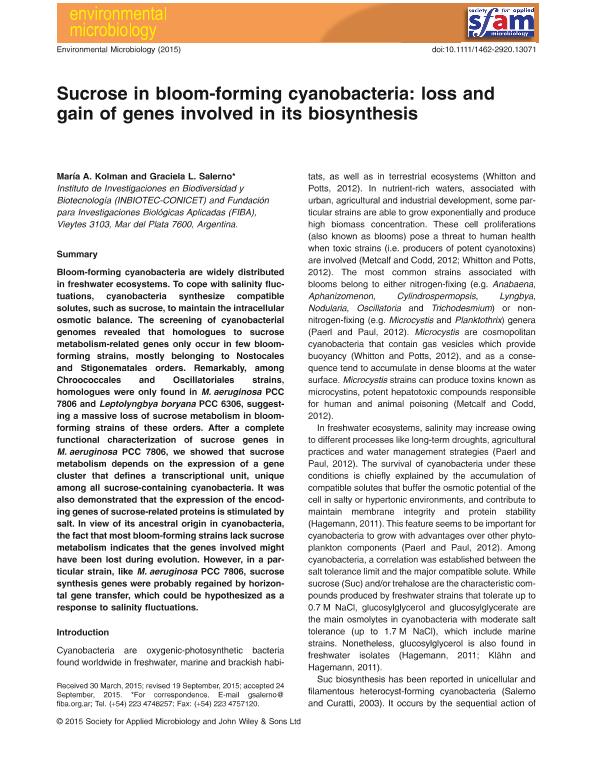Mostrar el registro sencillo del ítem
dc.contributor.author
Kolman, Maria de Los Angeles

dc.contributor.author
Salerno, Graciela Lidia

dc.date.available
2017-01-04T21:05:47Z
dc.date.issued
2016-02
dc.identifier.citation
Kolman, Maria de Los Angeles; Salerno, Graciela Lidia; Sucrose in bloom-forming cyanobacteria: loss and gain of genes involved in its biosynthesis; Wiley; Environmental Microbiology; 18; 2-2016; 439–449
dc.identifier.issn
1462-2912
dc.identifier.uri
http://hdl.handle.net/11336/10852
dc.description.abstract
Bloom-forming cyanobacteria are widely distributed in freshwater ecosystems. To cope with salinity fluctuations, cyanobacteria synthesize compatible solutes, such as sucrose, to maintain the intracellular osmotic balance. The screening of cyanobacterial genomes revealed that homologues to sucrose metabolism-related genes only occur in few bloomforming strains, mostly belonging to Nostocales and Stigonematales orders. Remarkably, among Chroococcales and Oscillatoriales strains, homologues were only found in M. aeruginosa PCC 7806 and Leptolyngbya boryana PCC 6306, suggesting a massive loss of sucrose metabolism in bloomforming strains of these orders. After a complete functional characterization of sucrose genes in M. aeruginosa PCC 7806, we showed that sucrose metabolism depends on the expression of a gene cluster that defines a transcriptional unit, unique among all sucrose-containing cyanobacteria. It was also demonstrated that the expression of the encoding genes of sucrose-related proteins is stimulated by salt. In view of its ancestral origin in cyanobacteria, the fact that most bloom-forming strains lack sucrose metabolism indicates that the genes involved might have been lost during evolution. However, in a particular strain, like M. aeruginosa PCC 7806, sucrose synthesis genes were probably regained by horizontal gene transfer, which could be hypothesized as a response to salinity fluctuations.
dc.format
application/pdf
dc.language.iso
eng
dc.publisher
Wiley

dc.rights
info:eu-repo/semantics/openAccess
dc.rights.uri
https://creativecommons.org/licenses/by-nc-sa/2.5/ar/
dc.subject
Cyanobacterial Blooms
dc.subject
Microcystis Aeruginosa
dc.subject
Sucrose
dc.subject
Salinity
dc.subject.classification
Otras Biotecnología del Medio Ambiente

dc.subject.classification
Biotecnología del Medio Ambiente

dc.subject.classification
INGENIERÍAS Y TECNOLOGÍAS

dc.title
Sucrose in bloom-forming cyanobacteria: loss and gain of genes involved in its biosynthesis
dc.type
info:eu-repo/semantics/article
dc.type
info:ar-repo/semantics/artículo
dc.type
info:eu-repo/semantics/publishedVersion
dc.date.updated
2017-01-02T18:33:57Z
dc.identifier.eissn
1462-2920
dc.journal.volume
18
dc.journal.pagination
439–449
dc.journal.pais
Estados Unidos

dc.journal.ciudad
Hoboken
dc.description.fil
Fil: Kolman, Maria de Los Angeles. Consejo Nacional de Investigaciones Científicas y Técnicas. Centro Científico Tecnológico Mar del Plata. Instituto de Investigaciones en Biodiversidad y Biotecnología; Argentina. Fundación para Investigaciones Biológicas Aplicadas; Argentina
dc.description.fil
Fil: Salerno, Graciela Lidia. Consejo Nacional de Investigaciones Científicas y Técnicas. Centro Científico Tecnológico Mar del Plata. Instituto de Investigaciones en Biodiversidad y Biotecnología; Argentina. Fundación para Investigaciones Biológicas Aplicadas; Argentina
dc.journal.title
Environmental Microbiology

dc.relation.alternativeid
info:eu-repo/semantics/altIdentifier/doi/http://dx.doi.org/10.1111/1462-2920.13071
dc.relation.alternativeid
info:eu-repo/semantics/altIdentifier/url/http://onlinelibrary.wiley.com/doi/10.1111/1462-2920.13071/abstract
Archivos asociados
